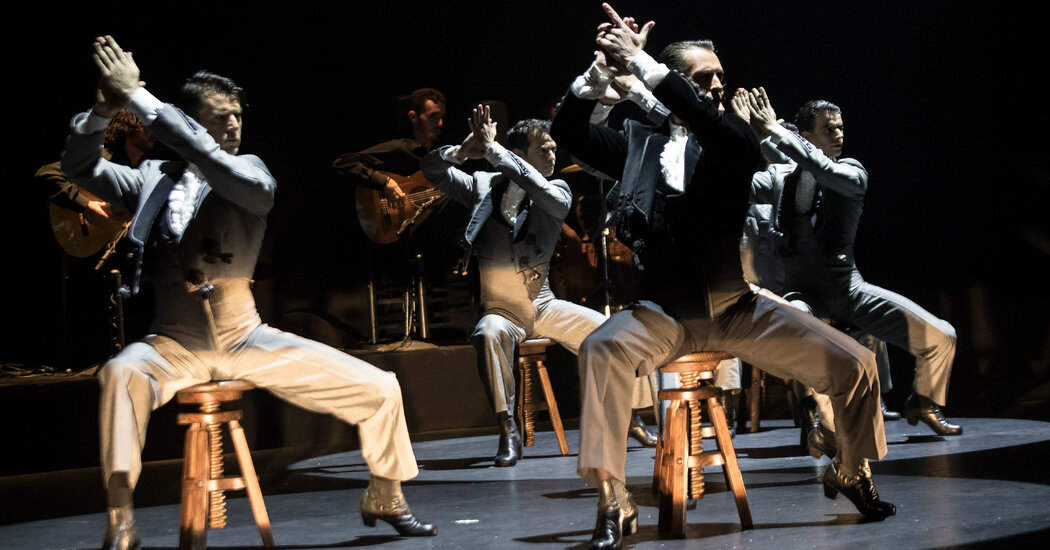The flamenco dancer Olga Pericet began topless, curled up on the floor like a beached mermaid or a woman recovering from a night of carousing. Her face was covered by a tightfitting mask with painted-on doll features. Later, she danced with a yellow raincoat over her head. She also stood on a bench in a pink wedding cake of a dress, with guitar-shaped cutouts festooning her arms, posing like a surrealist’s conception of a religious icon.
Her show, “La Leona,” was as far out as this year’s Flamenco Festival at New York City Center got. And still, it was rooted in the integrity of tradition. The heart of flamenco lies in the impassioned individual statement in a communal context, a musical conversation. So what might seem like improvements or expansions — elaborate group choreography, imaginative conceits — risk straying from the emotional core that makes flamenco flamenco. This year’s festival showed the risks and the rewards. If the intensity of the dance selections was lower than in some previous editions, the range was wider.
The festival didn’t even start with flamenco. Instead, the Ballet Nacional de España began its program on March 8 with “Invocación Bolera,” a modern evocation of the 18th-century escuela bolero, which is essentially Baroque ballet with Spanish poses and castanets.
This was a welcome switch, and “Invocación” had its charms, showing off a well-trained and large company. Eighteen dancers in period attire filled the stage, their castanets adding a chattering commentary to neat ballet jumps and turns, making them buzz. The choreography — by Rubén Olmo, the group’s artistic director — arranged the groupings adroitly.
A similar professionalism marked “Eterna Iberia,” by Antonio Najarro, though here the style was 20th-century theatricalized flamenco. Percussive footwork was multiplied in tight unison, groups moved in handsome lines and circles, castanets trilled and soloists broke out in displays of expertise.
Olmo’s “Jauleña,” a shape-shifting solo beautifully danced by Inmaculada Salomón, was more contemporary, mixing in modern-dance angularity. But the biggest difference between all this and Ballet Nacional’s final selection, “De Lo Flamenco,” was musical: a switch to live flamenco musicians from recorded orchestral compositions. At the Sunday matinee I attended, this change at least doubled the energy.
Otherwise, “De Lo Flamenco” — a tribute to the choreographer Mario Maya that gathers together some of his pieces with similar work by others — resembled “Eterna Iberia.” Maya was a master of this mode: smoothly shifting picturesque formations, synchronicity, impressive soloists. But with the live, idiomatic music, it was as if the mode had been plugged in and turned on.
Pericet’s “La Leona,” on Friday, benefited from excellent music all the way through. Guitars, vocals and percussion were updated with funky-fusion electric bass (played by the virtuosic Juanfe Pérez), but the thrust of Pericet’s experimentation was scenographic.
“La Leona,” or “The Lioness,” refers to its star but also to a 19th-century guitar. The show makes an analogy between the body of a guitar and that of a woman, although Pericet dances in a man’s suit, too. Her previous shows have been similarly eccentric in concept and costume, but I’ve often found her dancing to be overly careful and calculated. Not this time. Playing air guitar, Pericet strummed at crotch level. Declaring “I am hot,” she fanned those nether regions.
This was an artist having some fun. The comedy could be on the goofy side of dada, as when the percussionist and vocalist played rhythms with scissors. And dancing to a flamenco version of Thelonious Monk’s jazz classic “’Round Midnight,” Pericet strayed unconvincingly into the realm of Twyla Tharp or Bob Fosse. But the overall impression was of an artist steeped in tradition trying to avoid boredom. The nuttiness was winning, and the music maintained the integrity. She finished at her most traditional, like Picasso reminding people he could draw representationally, showing off her rhythmic play with some rock-star wildness.
The festival’s concluding “Gala Flamenca” is the most traditional format: musicians (here including the gale-force vocalist Sandra Carrasco) supporting solo dancers. Of the dancers, the most improved was Alfonso Losa. He is now an all-rounder, gorgeously re-sculpting arm positions mid-turn in perfect pirouettes, delivering rhythmic complexity and surprise in footwork both with and without the addition of a cane. And Miguel Fernández Ribas, known as El Yiyo, was the most disappointing. Hailed as a new star, he was loud, fast and awkward, not yet ready for prime time, not yet able to command a stage.
Choreographically, the strongest selection was a duet for Losa and Manuel Liñán, who staged the show. Now facing off, now mirroring, now side by side, the men conveyed a dueling energy that was periodically amped up with tambourines.
Though Paula Comitre’s footwork was muddy, she handled the long-tailed bata de cola dress and a fan with rare expressivity. Fanning herself in a deep backbend, she evoked melancholic languor. Spinning and spinning with the dress’s tail trailing her, she looked lost, wrapped up in sadness.
Liñán also wore a bata de cola for his climactic solo. Such cross-gender costuming has lately become his signature. Dancing the serious form solea, he spun with enough effortful, tornado-like force that I half expected to see smoke. Like Pericet, Liñán clearly knows the rules that he is bending. His idea of tradition isn’t dead.

